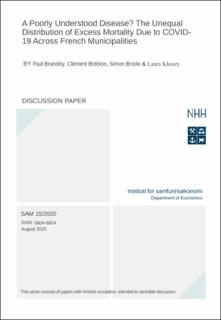A Poorly Understood Disease? The Unequal Distribution of Excess Mortality Due to COVID-19 Across French Municipalities
| dc.contributor.author | Brandily, Paul | |
| dc.contributor.author | Brébion, Clément | |
| dc.contributor.author | Briole, Simon | |
| dc.contributor.author | Khoury, Laura | |
| dc.date.accessioned | 2020-08-28T11:09:24Z | |
| dc.date.available | 2020-08-28T11:09:24Z | |
| dc.date.issued | 2020-08 | |
| dc.identifier.issn | 0804-6824 | |
| dc.identifier.uri | https://hdl.handle.net/11250/2675528 | |
| dc.description.abstract | While COVID-19 was responsible for more than 600,000 deaths worldwide as of July 24, 2020, very little is known about the socio-economic heterogeneity of its impact on mortality. In this paper, we combine several administrative data sources to estimate the relationship between mortality due to COVID-19 and poverty at a very local level (i.e. the municipality level) in France, one of the most severely hit countries in the world. We find strong evidence of an income gradient in the impact of the pandemic on mortality rates, which is twice as large in municipalities below the 25th percentile of the national income distribution than in municipalities above this threshold. We then show that both poor housing conditions and higher occupational exposure play a key role in this heterogeneity: taken together, these mechanisms account for up to 77% of the difference observed between rich and poor municipalities. | en_US |
| dc.language.iso | eng | en_US |
| dc.relation.ispartofseries | DP SAM;15/2020 | |
| dc.subject | COVID-19 ; poverty; inequality; mortality; labor market; housing conditions | en_US |
| dc.title | A Poorly Understood Disease? The Unequal Distribution of Excess Mortality Due to COVID-19 Across French Municipalities | en_US |
| dc.type | Working paper | en_US |
| dc.subject.nsi | Samfunnsvitenskap | en_US |
| dc.source.issue | 39 | en_US |
| dc.relation.project | 262675 | en_US |
Tilhørende fil(er)
Denne innførselen finnes i følgende samling(er)
-
Discussion papers (SAM) [649]
